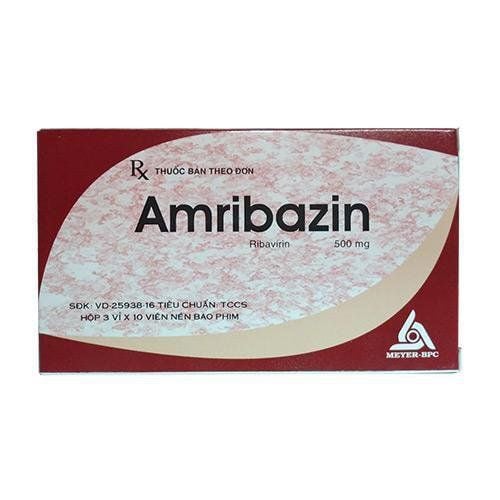This is an automatically translated article.
The drug Heptavir has the main ingredient Lamivudine, which is made in the form of film-coated tablets. Heptavir is indicated for the treatment of hepatitis B. Let's understand the uses of Heptavir and important notes when taking it in the article below.
1. What is Heptavir?
Heptavir has the main ingredient Lamivudine 150mg and other excipients just enough for 1 tablet.
Packing: Box of 1 vial x 60 tablets Dosage form: Film-coated tablets Manufacturer: Hetero Drugs Ltd - India Registration number: VN3-198-19 Pharmacodynamics
Lamivudine is an antiretroviral drug, belonging to dideoxynucleoside group, inhibits viral reverse transcriptase. The drug has competitive activity with natural deoxycytidine triphosphate for incorporation into viral DNA by reverse transcriptase, causing premature termination of viral DNA synthesis. Lamivudine has antiviral activity against HIV types 1 and 2 and also inhibits hepatitis B virus in chronic patients.
Pharmacokinetics
Lamivudine is rapidly absorbed with a bioavailability of about 80% after oral administration. The mean plasma elimination half-life is 2.5 hours and about 70% of the dose is excreted unchanged in the urine.
2. Indications and contraindications of Heptavir
Heptavir is indicated for use in the treatment of:
Chronic hepatitis B Combined treatment of HIV infection Contraindicated to use Heptavir in cases of hypersensitivity to any ingredient in the drug. Heptavir.
3. Dosage and treatment
3.1. Dosage For adults and children over 12 years:
The recommended dose of Heptavir is 100 mg once daily. Discontinue use in patients with a normal immune response when a HBeAg seroconversion response occurs and /or HbsAg. For children under 12 years old: recommended dose is 3 mg/kg x 1 time/day (maximum 100 mg/day)
For HIV infection:
Adults and adolescents over 16 years old
Weight ≥ 50 kg: 300 mg of Zidovudine and 150 mg of Lamivudine, every 12 hours.
Weight < 50 kg: 4 mg Zidovudine/kg body weight and 2 mg Lamivudine/kg body weight, every 12 hours.
Adolescents 12 years and older up to 16 years:
Weight ≥ 50 kg: 300 mg of Zidovudine and 150 mg of Lamivudine, every 12 hours.
Weight < 50 kg: There are not enough data to guide the dose.
Children from 3 months to 12 years: 4 mg Lamivudine/kg every 12 hours, up to 300mg Lamivudine per day.
Patients with renal failure: reduce the dose.
Creatinine clearance 30–49ml/min: 150 mg, once daily Creatinine clearance 15–29ml/min: First day 150 mg; days after 100 mg, once a day. Creatinine clearance 5–14ml/min: First day 150 mg; the following days 50 mg, once a day. Creatinine clearance < 5ml/min: First day 50 mg; the following days 25 mg, once a day. For chronic hepatitis B:
Adults: 100mg, once a day. Children over 2 years old: 3mg/kg, once a day; up to 100 mg/day. Patients with renal impairment: reduce the dose as directed by the physician. For cases of concurrent infection with hepatitis B virus and HIV: It is necessary to use antiretroviral doses of HIV.
3.2. Treatment of missed dose, overdose Overdose
In the case of overdosing Heptavir compared to prescribed and having abnormal symptoms, it is necessary to immediately call 911 Emergency Center or go to the nearest medical facility.
Missed dose
During the use of Heptavir, patients need to follow the doctor's treatment schedule to avoid the occurrence of missed doses that reduce the effectiveness of treatment. If you miss a dose of Heptavir, use the missed dose as soon as you remember (it can be taken 1-2 hours before the time prescribed by the doctor). But if it is too close to the next dose, skip the missed dose and take the next dose exactly as prescribed. Patients should not double the dose of Heptavir.
4. Side effects of Heptavir
During the use of Heptavir, you may experience some specific side effects as follows:
Common: Irritability, fatigue, headache, insomnia, dizziness, depression, pain, fever, chills, nausea, vomiting, anorexia, dyspepsia, diarrhea, increased amylase, peripheral neuropathy, paresthesia, myalgia, arthralgia, cough, rash, anemia, neutropenia, elevated ALT, AST. Uncommon: Hyperbilirubinemia, thrombocytopenia, pancreatitis.
5. Notes when taking Heptavir
During the use of Heptavir, the patient should pay attention to the following issues:
The patient may have a relapse of chronic hepatitis B after stopping lamivudine. Therefore, periodic clinical monitoring and serum liver function testing should be performed for a minimum of 4 months for evidence of recurrent viral hepatitis. In patients with concomitant HIV infection, lamivudine 150 mg twice daily should be maintained. Children with a history of pancreatitis or risk factors for the development of pancreatitis: Close monitoring is required when lamivudine is used in combination with zidovudine. . When there are abnormal clinical signs, the drug should be discontinued immediately. People with impaired renal function, adolescents weighing less than 50 kg and children under 12 years of age: Do not use fixed combination preparations containing Zidovudine and Lamivudine, because no individual medication can be adjusted. Lamivudine does not cure HIV infection. Therefore, patients still need to be monitored and cared for continuously. Lamivudine does not reduce the risk of HIV transmission, so patients must use condoms to protect their partners. Pregnant women can take Lamivudine, especially when there is a chance of protection from infection to the unborn baby. However, when using Lamivudine in combination with oral administration (Lamivudine and Zidovudine tablets), avoid using the drug for pregnant women.
6. Drug interactions
Possible drug interactions when taking Heptavir are:
When co-administered with Lamivudine, the plasma concentration of Zidovudine is significantly increased (approximately 39%) Trimethoprim/Sulfamethoxazole increases the bioavailability of Lamivudine (44%) ) as measured by the area under the concentration-time curve (AUC), and reduced renal clearance (30%). Although AUC was not significantly affected, absorption of Lamivudine was slowed and peak plasma concentrations were 40% lower when the drug was administered at fullness to patients compared with the fasted dose. In the process of using Heptavir, patients should pay attention to follow the doctor's instructions, carefully read the notes before taking it to get the most effective treatment, and limit possible side effects. happen.
Please dial HOTLINE for more information or register for an appointment HERE. Download MyVinmec app to make appointments faster and to manage your bookings easily.













